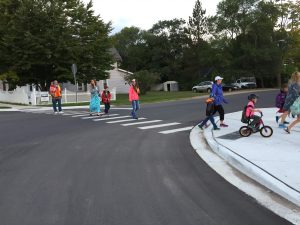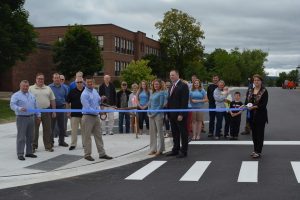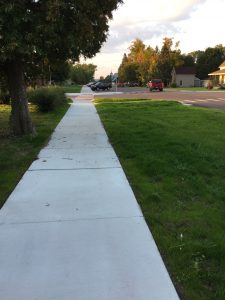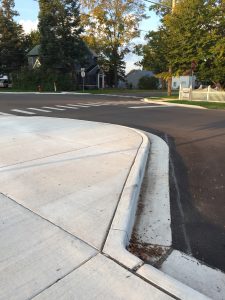Tucked away about an hour northeast of Traverse City along a section of Lake Charlevoix, East Jordan is a year around destination. Tourists can be seen flocking to nearby beaches in the summertime and taking in some of Michigan’s best skiing in the winter. In short, East Jordan offers things that are familiar to and beloved by Michiganders, with its own spin. This uniqueness is embodied community wide and was evident in their Safe Routes to School (SRTS) project. East Jordan delivered their SRTS project with their own twist thanks to the help of the stakeholders…and the East Jordan High School welding students.

Pursuing SRTS funding in 2016 was an easy choice for local officials. Numerous hazards existed in the vicinity of their schools that made walking and rolling to school unsafe. Mill Street, which is the main roadway connected to the high school and middle school, is connected to highway M-32, leading to high traffic volume and high speeds. With that in mind, getting kids onto alternative routes would need to be a central focus. Many areas were also devoid of sidewalks altogether, or if they had them, they were often broken and overgrown with tree roots. Without a proper place to walk, kids had little choice. As noticed by Superintendent Matt Stevenson: “I’d see kids walking down the middle of the road in the winter walking to the middle school. And I was like, ‘Holy cow, this is not safe.’”
Stevenson, along with City Administrator Tom Cannon, summoned the help of District Health Aide and Nurse Pattie Howes. She would help lead the district through the grant application process. Together, the three of them represented three pillars of local leadership: city administration, the school district, and nearby Charlevoix Hospital. Each entity worked as a safeguard, helping to assure the success of the project. But they were not alone in their work. The team found that their community was overwhelmingly supportive of the SRTS project. Stevenson observed how the project brought out the best in the entire city, helping to form strong working relationships that exist to this day: “There was definitely some leadership that grew in my organization specifically. This project started a great relationship between Tom Cannon and me. This was one of the first projects we really worked on together and it created that collaboration and togetherness between the school and the community that’s been a powerful and great resource for us.”
The physical infrastructure improvements centered on diverting school walking and rolling traffic off Mill Street and onto Porter Street one block over. This meant repairing and replacing sections of sidewalk along with adding ADA accessible ramps in many of the same spots. A few places of particular importance received curb bump outs— sections of sidewalk that are extended from each side of the street to slow down drivers and shrink the distance that those crossing must travel. These and other crosswalks were restriped to aid visibility, school zone notice markings were painted, and radar/speed reduction signs were strategically placed. The city even developed a remote drop-off site, which diffuses traffic near the school and allows even dropped-off students to have a chance to experience some benefits of walking and rolling to school.
East Jordan also found they had great participation in annual events like Bike to School and Walk to School Day, as well as their bike rodeo event and recurring Walking Wednesdays. They went out of their way to provide a variety of educational opportunities for students, such as showing them around pathways near local schools, devoting time in Physical Education classes and special assemblies to address pedestrian safety, holding a bike rodeo, and hosting a special presentation by the group Wonder Wheels BMX that promoted bicycle safety.
All of this alone would have demonstrated an above-and-beyond effort, but East Jordan looked at every avenue for enhancing its project. When officials decided to add a bike rack on the school grounds, most would have simply bought the rack and dropped it in place. But East Jordan saw an opportunity. The team purchased raw materials and deployed its high school welding students to assemble it. There were some difficulties attached with this innovation as certain qualifications had to be met to ensure grant funding would be available. The steel had to be American made, and having the students build the project required some double checking on billing and funding protocols. But in the end, the idea was the perfect cap on a wonderfully inventive and thoughtful project.
Superintendent Stevenson noted the pride associated with the bike rack and witnessed how learning and the time investment facilitated student buy-in: “Kids became so much more understanding that this is not just an adult thing. And when you get a bike rack [installed] that the kids made, no one is going to damage it.”

When any community completes a SRTS project, it’s a win-win for all involved. Community partnerships are formed and lines of communication open between various agencies and stakeholders last for years while attractive new pathways allow citizens to better traverse their towns. At the center of it all, students gain the ability to walk, bike, and roll to and from school safely, helping them make friends, learn about their surroundings, and get in some of the physical activity they need to live healthier lives. While each SRTS project realizes the aforementioned benefits, the City of East Jordan went a step further by involving the students who put their signature on the SRTS project by creating a bike rack. That bike rack now stands as a beacon by inviting all students to ride and park their bikes at school for years to come.
“We’re probably looking at eight years later here and you still see pieces of this project to this day,” said Superintendent Stevenson.
Project Impact:
East Jordan’s SRTS project helps kids stay on the sidewalk and off busy streets. A variety of different infrastructure investments from new sidewalk construction and curb bump outs to ADA accessible ramps and enhanced signage, they helped increase safety, encourage physical activity, and support active living to help their community live healthier lives. Numerous events and non-infrastructure initiatives have contributed to community buy-in and created relationships between local officials that have far outlasted the initial project. With pieces like the student-built bike rack, this SRTS project shows no signs of slowing down.
- MDOT Infrastructure Investment: $395,466.00
- MDOT Non-infrastructure Investment: $15,963.00
This project was made possible through the continuing collaborative efforts of the City of East Jordan, East Jordan Public Schools, Michigan Fitness Foundation, Michigan Department of Transportation, and the Federal Highway Administration.


